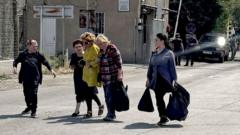In recent days, a growing number of Iranians have made the arduous journey on foot to cross the border into Armenia, driven by an increasingly vocal desire for regime change in Iran. Mariam, a pensioner, shared her experience as she collapsed into a taxi after dragging heavy suitcases over a bridge spanning the Aras River, which delineates Iran's northern boundary with Armenia. “People want regime change," she stated, reflecting the concerns of many fleeing the country.
The mood in Iran is nuanced, with some feeling optimistic about potential changes, while others remain apprehensive. Mariam observed that life continues with the ordinary functioning of supermarkets and banks, but sentiments are mixed regarding the impact of external forces like the US and Israel. "I don't know if they'll succeed, or whether the religious fanatics in Tehran will hold their ground," she mused.
At the Agarak border crossing, reporters observed a steady influx of people seeking refuge. This border serves as a rare window into the situation in Iran, where internet disruptions and restrictions on foreign journalists create significant barriers to understanding the wider public sentiment. Many of those crossing were dual nationals, resulting in a limited view of the population's emotions regarding the current regime.
While the concept of regime change was popularized by President Trump after recent US military strikes on Iranian nuclear facilities, it remained a contentious topic among those we spoke to. Support for Iran's leadership still exists, and opinions are divided on foreign intervention even among critics of the regime.
The border point was alive with the movement of people, where Canadian diplomats noted a sharp increase in arrivals. An individual known as Alenoosh, reminiscing about her background, expressed that “time is up for the regime” and claimed that fear is pervasive among the populace.
Some families, like a group of Canadian-Iranians, described their recent experiences in Iran as chaotic, depicting a nation both troubled and curiously unaffected in parts by the unfolding crisis. Meanwhile, another Iranian father, now in Germany, expressed a determination for change, insisting that it may require sacrifices.
The implications of US actions and the internal dynamics within Iran may incite further waves of migration. With the situation escalating, the coming days are likely to demand critical decisions from global leaders that could influence the scope of this displacement. How these developments unfold may shape not only the lives of those currently fleeing but also the future of Iran itself.
The mood in Iran is nuanced, with some feeling optimistic about potential changes, while others remain apprehensive. Mariam observed that life continues with the ordinary functioning of supermarkets and banks, but sentiments are mixed regarding the impact of external forces like the US and Israel. "I don't know if they'll succeed, or whether the religious fanatics in Tehran will hold their ground," she mused.
At the Agarak border crossing, reporters observed a steady influx of people seeking refuge. This border serves as a rare window into the situation in Iran, where internet disruptions and restrictions on foreign journalists create significant barriers to understanding the wider public sentiment. Many of those crossing were dual nationals, resulting in a limited view of the population's emotions regarding the current regime.
While the concept of regime change was popularized by President Trump after recent US military strikes on Iranian nuclear facilities, it remained a contentious topic among those we spoke to. Support for Iran's leadership still exists, and opinions are divided on foreign intervention even among critics of the regime.
The border point was alive with the movement of people, where Canadian diplomats noted a sharp increase in arrivals. An individual known as Alenoosh, reminiscing about her background, expressed that “time is up for the regime” and claimed that fear is pervasive among the populace.
Some families, like a group of Canadian-Iranians, described their recent experiences in Iran as chaotic, depicting a nation both troubled and curiously unaffected in parts by the unfolding crisis. Meanwhile, another Iranian father, now in Germany, expressed a determination for change, insisting that it may require sacrifices.
The implications of US actions and the internal dynamics within Iran may incite further waves of migration. With the situation escalating, the coming days are likely to demand critical decisions from global leaders that could influence the scope of this displacement. How these developments unfold may shape not only the lives of those currently fleeing but also the future of Iran itself.

















